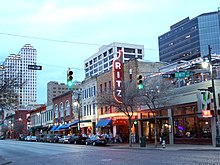Ritz (Austin, Texas)

Ritz, circa 2006
|
|
| Address | 320 E 6th St Austin, Texas |
|---|---|
| Coordinates | 30°16′02″N 97°44′23″W / 30.26731°N 97.73961°W |
| Owner | Larry Craddock |
| Type | Movie theater |
| Capacity | 175 |
| Construction | |
| Opened | October 13, 1929 |
| Rebuilt | 2007 |
| Years active | 1929–1964 1970–present |
| Architect | Hugo Kuehne |
| Website | |
| www.originalalamo.com | |
The Ritz is a historic theater in the 6th Street district in Austin, Texas. The building's history includes use as a movie theater, music hall, club, and comedy house. It reopened after renovations in fall 2007 as the new downtown location for the Alamo Drafthouse.
The Ritz was built in 1929 by J.J. Hegman, who owned several movie theaters in Austin, Texas. It was the first theater in Austin to be built specifically for the talkies. The architect was Hugo Kuehne, the founding dean of the University of Texas School of Architecture, who also designed the Austin History Center (originally the Austin Public Library). The Ritz was originally a long narrow space, and was segregated like most movie theaters in Texas and other southern states at that time; there was a separate entrance leading to a balcony reserved for people of color.
The theater opened on 6th Street on October 13, 1929. It showed primarily first-run westerns with a lower ticket price than any other theater in town and frequently brought in stars like Wild Bill Elliott and Dub Taylor, along with country music acts who performed before the movies.
In 1937, Hegman's son Elmo took over management and expanded the theater to 800 seats by widening the theater by 25 feet. He continued showing Westerns until television siphoned off the audience; Elmo closed the theater in 1964.
Cary White, the production designer for The Faculty and Spy Kids, amongst other movies, was the projectionist and janitor at the Ritz during some of its last days as a movie house.
The theater remained shuttered until 1970, when it re-opened for three years as an adult theater. In October 1974, entrepreneurs Jim Franklin (artist) and Bill Livinggood renovated the theater and opened the doors as a music venue, offering an eclectic mix of programming from classical to rock and including live theater and movies. This was also short-lived, and the club closed in 1975. Several other groups moved in over the years. The Center Stage theater group took it over in 1977, closing off the balcony to make a second, separate theater. Again, the venue didn't last long and the late 1970s saw a serious decline in the theater's fortunes, including another stint into porn exhibition.
...
Wikipedia
